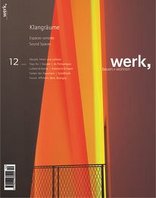Zeitschrift
werk, bauen + wohnen 12-06
Klangräume
Like the experience of space, memory is also made up of both images and sounds. Architects are familiar with the image: it is omnipresent and is seen as the measure of what has been built. Sound, however, is often only thought of later. In the opening essay to this issue Pierre Mariétan urges that hearing should more often become listening and that we should train our hearing in order to refine both our perception of the sounds we hear in everyday life and also our „inner ear“. And regarding this inner ear Glenn Gould once described an incident from his youth: he was playing Mozart when suddenly a vacuum cleaner was switched on beside his instrument. This placed such an extreme demand on the young piano player's ability to imagine sound that he later recreated the situation whenever he had to learn a new score. Having even a fraction of this power of imagination would be desirable for architects when designing space: as a result spaces might no longer freeze as perspective images but could begin to vibrate with possible sounds. In his essay on the relationship between seeing and hearing in the history of the concert hall Jürg Jecklin uses a number of different examples from the 18th and 19th centuries and comes to an interesting conclusion. The article about acoustic pots in the mediaeval churches takes a look further back into the past. And a contribution about the different colours of noise listens to contemporary background sounds. It is difficult to approach the sounds of a building through reading or writing, but the five buildings we present in this issue have made the task somewhat easier for us. They provide spaces for rock music and classical concerts, in larger and smaller settings, for theatre performances and also for speech training and therapy. Depending on its place and function each of these building makes a different gesture to the outside. The sounds, words and music in the interior remain inscribed in the architecture as a memory, even after they have faded away. We hope that the texts and the images will awaken readers' curiosity about their sonic potential. The Philharmonics in Luxembourg resembles an almond raised on a platform that suggests an internal life through its veil of columns. In the music room in Gaasbeek the structure of the bricks links inside and outside and allows sounds to move freely in space. The concert and performance centre in Matsumoto interprets the form of the site as a guitar. The Lausanne University Hospital pavilion for phoniatrics and speech therapy is made up of a transparent shell around the concrete core, thus reversing the normal order of hard and soft, while the Kofmehl culture factory in Solothurn is a rusty block with a vital internal life. These buildings were all differently planned and constructed and so they all sound different – or: they each sound different because each of them was designed according to an individual idea. The editors
Thema
Pierre Mariétan
Décomposer – recomposer Über die akustische Wahrnehmung des Alltags
Jürg Jecklin
Raumakustik im Wandel der Zeit Zum Verhältnis von sichtbarem und hörbarem Raum
Kurt Handlbauer
Eine Gitarre für Matsumoto Matsumoto Performing Arts Centre von Toyo Ito & Associates, Architects
Nott Caviezel
Schalltöpfe Eine Miszelle zur Akustik im Mittelalter
Sabine von Fischer
Die Farben des Rauschens Hintergrundgeräusche zeitgenössischer Innenräume
Martin Tschanz
Leise und deutlich Pavillon für Phoniatrie und Logopädie des Universitätsspitals Lausanne von Galletti & Matter
Christoph Schläppi
Geliebte Hütte Kulturfabrik Kofmehl, Solothurn, von Stäuble Architekten
Sven Sterken
Musik unter einer Dachlandschaft Musikraum in Gaasbeek, Belgien, von Robbrecht & Daem Architekten
Richard Scoffier
Eine Architektur des Zuhörens Philharmonie in Luxemburg von Christian de Portzamparc
Forum
Kolumne: Igor Bauersima
EFH: Einfamilienhaus in Hinwil von Beat Rothen
Wettbewerb: Studienauftrag Losinger Construction AG für den Hauptsitz Schweiz in Bern
Innenarchitektur: Umbau Radiostudio DRS1, Zürich von Di Gallo Architekten und applied acoustics
Design: Vom Klang der Produkte
Landschaftsarchitektur: Gartenjahr 2006
Bauten: Gemeindeverwaltungszentrum in Affoltern am Albis von Müller Sigrist Architekten
Bauten: Hôtel de ville in Bussigny-près-Lausanne von Bakker & Blanc architectes, Lausanne und Concept Consult Architectes, Lausanne
bauen + rechten
Ausstellungen | Veranstaltungen | Wettbewerbe
Neuerscheinungen | Produkte
BSA: Neumitglieder 2006
werk-Material
Müller Sigrist Architekten, Zürich: Gemeindeverwaltungszentrum in Affoltern am Albis, ZH
Bakker & Blanc architectes, Lausanne, Concept Consult Architectes, Lausanne: Hôtel de ville in Bussigny-près-Lausanne, VD
Thema
Pierre Mariétan
Décomposer – recomposer Über die akustische Wahrnehmung des Alltags
Jürg Jecklin
Raumakustik im Wandel der Zeit Zum Verhältnis von sichtbarem und hörbarem Raum
Kurt Handlbauer
Eine Gitarre für Matsumoto Matsumoto Performing Arts Centre von Toyo Ito & Associates, Architects
Nott Caviezel
Schalltöpfe Eine Miszelle zur Akustik im Mittelalter
Sabine von Fischer
Die Farben des Rauschens Hintergrundgeräusche zeitgenössischer Innenräume
Martin Tschanz
Leise und deutlich Pavillon für Phoniatrie und Logopädie des Universitätsspitals Lausanne von Galletti & Matter
Christoph Schläppi
Geliebte Hütte Kulturfabrik Kofmehl, Solothurn, von Stäuble Architekten
Sven Sterken
Musik unter einer Dachlandschaft Musikraum in Gaasbeek, Belgien, von Robbrecht & Daem Architekten
Richard Scoffier
Eine Architektur des Zuhörens Philharmonie in Luxemburg von Christian de Portzamparc
Forum
Kolumne: Igor Bauersima
EFH: Einfamilienhaus in Hinwil von Beat Rothen
Wettbewerb: Studienauftrag Losinger Construction AG für den Hauptsitz Schweiz in Bern
Innenarchitektur: Umbau Radiostudio DRS1, Zürich von Di Gallo Architekten und applied acoustics
Design: Vom Klang der Produkte
Landschaftsarchitektur: Gartenjahr 2006
Bauten: Gemeindeverwaltungszentrum in Affoltern am Albis von Müller Sigrist Architekten
Bauten: Hôtel de ville in Bussigny-près-Lausanne von Bakker & Blanc architectes, Lausanne und Concept Consult Architectes, Lausanne
bauen + rechten
Ausstellungen | Veranstaltungen | Wettbewerbe
Neuerscheinungen | Produkte
BSA: Neumitglieder 2006
werk-Material
Müller Sigrist Architekten, Zürich: Gemeindeverwaltungszentrum in Affoltern am Albis, ZH
Bakker & Blanc architectes, Lausanne, Concept Consult Architectes, Lausanne: Hôtel de ville in Bussigny-près-Lausanne, VD
Weiterführende Links:
Verlag Werk AG







